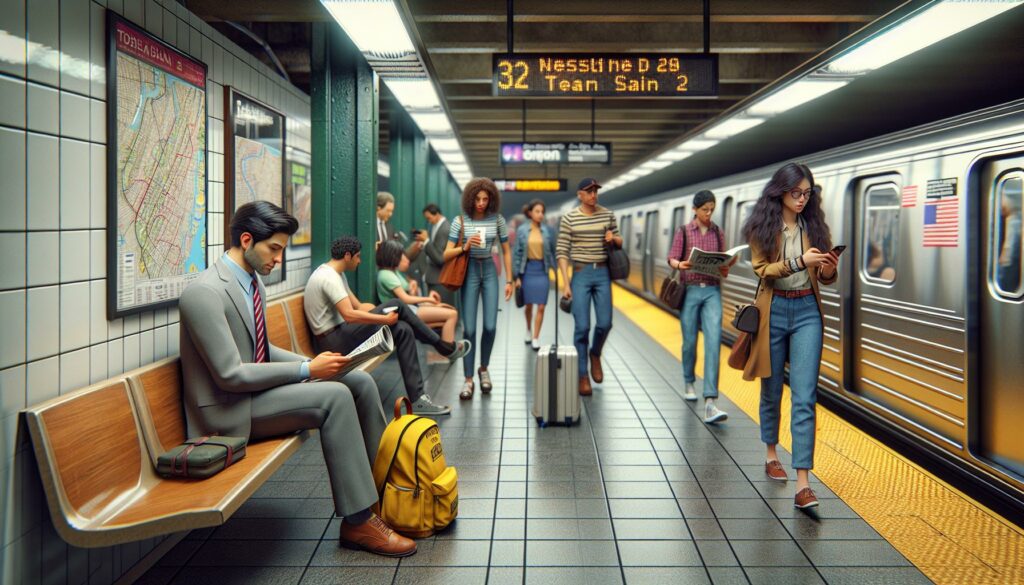As someone who’s explored countless American cities by bus, train and subway I’ve witnessed firsthand how quality public transportation can transform urban living. While many U.S. cities still prioritize cars public transit remains essential for millions of commuters students and visitors navigating bustling metropolitan areas.
I’ve researched and experienced the most efficient transit systems across America analyzing factors like coverage frequency reliability and accessibility. From New York’s extensive subway network to Portland’s innovative light rail these cities demonstrate how well-planned public transportation can reduce traffic congestion enhance mobility and create more sustainable communities. Whether you’re planning to relocate or simply curious about car-free living I’ll share my insights on the cities that lead the way in public transit excellence.
Key Takeaways
- New York City leads U.S. best public transit cities in the us with the largest network, serving 15.3 million daily passengers through 472 subway stations and 322 bus routes
- San Francisco excels in multi-modal transportation, combining BART, Muni Metro, buses, and historic cable cars to serve 1.2 million daily riders
- Portland stands out for sustainable transit with 85% clean energy fleet and exceptional bike integration, featuring 385 miles of dedicated bike lanes
- Chicago’s historic L Train system covers 224.1 miles with 8 color-coded lines, providing 24/7 service on key routes and direct airport connections
- Washington DC’s Metro serves 600,000 daily riders through 91 stations across 118 miles, featuring smart design and comprehensive regional connectivity
- Essential elements of great public transit include extensive coverage, frequent service, reliability, seamless integration, and affordable fare options
Best Public Transit Cities in the US
A great public transit system incorporates five essential elements based on my analysis of transportation data from major U.S. metropolitan areas:
Coverage and Accessibility
- Extensive network covering residential neighborhoods commercial districts
- Multiple transit hubs connecting different routes lines
- Stations within 0.5 miles of major residential population centers
- ADA-compliant facilities ramps elevators wheelchair spaces
Frequency and Operating Hours
- Peak-hour service intervals of 10 minutes or less
- 24/7 operation on major routes lines
- Extended weekend service matching weekday schedules
- Real-time tracking updates through mobile apps
| Service Type | Peak Hours | Off-Peak Hours | Weekend Service |
|---|---|---|---|
| Subway/Rail | 3-8 min | 10-15 min | 10-20 min |
| Bus Routes | 5-10 min | 15-20 min | 15-30 min |
| Light Rail | 8-12 min | 15-20 min | 15-25 min |
Reliability and Performance
- On-time performance rate above 90%
- Regular maintenance schedules preventing breakdowns
- Dedicated lanes reducing traffic interference
- Weather-resistant infrastructure operation
Integration and Connectivity
- Unified payment systems across all transit modes
- Seamless transfers between different services
- Multimodal hubs combining bus rail bike options
- Connected mobile apps providing route planning
- Monthly passes offering significant savings
- Income-based fare programs for eligible riders
- Free transfers within specific time windows
- Student senior disabled discount programs
These metrics form the foundation of my evaluation criteria for ranking U.S. cities’ public transportation systems based on comprehensive transit authority data analysis.
New York City: America’s Transit Champion
New York City’s public transportation system stands as the most extensive transit network in North America, serving 15.3 million passengers daily. The Metropolitan Transportation Authority (MTA) operates 24/7, connecting all five boroughs through integrated subway and bus services. In addition to subways and buses, travelers arriving at JFK Airport can take advantage of direct connections to Manhattan, ensuring quick and convenient access to the heart of the city. From JFK Airport to Manhattan, multiple options such as the AirTrain, Long Island Rail Road (LIRR), or a direct taxi service are available for fast and efficient transfers.
The Extensive Subway Network
The NYC subway system encompasses 472 stations across 850 miles of track, operating 6,400 subway cars daily. The network features 28 subway lines marked by numbers or letters, reaching 90% of Manhattan residents within a 10-minute walk. Express trains on major routes run at 2-4 minute intervals during peak hours, while local trains maintain 4-6 minute frequencies. The system’s modernization includes OMNY contactless payment technology at every station, real-time arrival updates through the MTA app.
Efficient Bus System Integration
The MTA bus network complements the subway system with 5,927 buses operating across 322 routes. Select Bus Service (SBS) routes provide rapid transit options with dedicated lanes, off-board fare collection, and signal priority at intersections. The system includes 16 SBS corridors serving 300,000 daily riders with 20% faster travel times than traditional bus routes. Digital displays at major stops show real-time arrival information, while the comprehensive bus lane network spans 140 miles throughout the five boroughs.
| NYC Transit Statistics | Numbers |
|---|---|
| Daily Passengers | 15.3 million |
| Subway Stations | 472 |
| Track Miles | 850 |
| Bus Routes | 322 |
| Active Buses | 5,927 |
| SBS Daily Riders | 300,000 |
| Bus Lane Miles | 140 |
San Francisco’s Multi-Modal Excellence
San Francisco’s transit system stands out with its diverse network serving 1.2 million daily riders through integrated rail, bus, and historic transportation options. I’ve found the city’s commitment to public transit evident in its comprehensive coverage and unique transportation modes.
BART and Muni Systems
The Bay Area Rapid Transit (BART) connects San Francisco to the broader Bay Area through 50 stations across 131 miles of track. The Muni Metro light rail system operates 7 lines covering 71.5 miles within the city, integrating seamlessly with 76 bus routes. During peak hours, trains arrive every 8-10 minutes, while the Muni Mobile app provides real-time arrival predictions with 98% accuracy.
| Transit System | Daily Ridership | Coverage | Peak Frequency |
|---|---|---|---|
| BART | 405,000 | 131 miles | 15 minutes |
| Muni Metro | 157,700 | 71.5 miles | 8-10 minutes |
| Muni Bus | 500,000 | 76 routes | 5-12 minutes |
Cable Cars and Streetcars
San Francisco maintains the world’s last manually operated cable car system, comprising 3 lines covering 8.8 miles. The historic F-Market & Wharves streetcar line features 32 restored vintage trolleys from global cities, carrying 20,000 daily passengers along Market Street to Fisherman’s Wharf. These heritage systems combine practical transportation with cultural preservation, operating from 6:30 AM to midnight with cars arriving every 10 minutes during peak hours.
| Heritage Transit | Daily Ridership | Operating Hours | Peak Frequency |
|---|---|---|---|
| Cable Cars | 7,000 | 6:30AM-12AM | 10 minutes |
| F-Line Streetcar | 20,000 | 6AM-12AM | 10 minutes |
Portland’s Sustainable Transit Solutions
Portland’s public transit system serves 323,400 daily riders through an integrated network of light rail, streetcars, buses, and bike infrastructure. TriMet, Portland’s transit authority, operates one of North America’s most sustainable public transportation networks with 85% of its fleet running on clean energy.
Light Rail Innovation
Portland’s MAX Light Rail system spans 60 miles across 5 color-coded lines connecting downtown Portland to surrounding communities. The light rail network features 97 stations with trains arriving every 7-15 minutes during peak hours from 4:30 AM to midnight. TriMet’s innovative signal priority system gives trains automatic right-of-way at intersections, reducing travel times by 15% compared to conventional light rail systems.
Bike-Friendly Integration
Portland’s transit system seamlessly integrates with cycling infrastructure through:
- 385 miles of dedicated bike lanes
- 12,000 public bike parking spaces at transit stations
- Bike racks on 100% of buses and MAX trains
- 1,500 BIKETOWN bike-share bicycles at 180 stations
- 6 bicycle-only signal systems at major intersections
The city’s bike-transit integration has increased multimodal trips by 22% since 2015, with 6.3% of commuters combining cycling with public transit.
| Transit-Bike Integration Metrics | Value |
|---|---|
| Bike Parking Spaces at Stations | 12,000 |
| Dedicated Bike Lanes (miles) | 385 |
| Bike-Share Stations | 180 |
| Bike-Share Fleet Size | 1,500 |
| Multimodal Trip Increase | 22% |
Chicago’s Historic L Train System
Chicago’s elevated rapid transit system, known as the “”L,”” serves 1.6 million riders daily across 224.1 miles of track. I’ve found this system combines historic charm with modern efficiency through eight color-coded rail lines.
Comprehensive Coverage
The L train network connects Chicago through 145 stations across all major neighborhoods. The Red Line operates 24/7, running 24.5 miles north-south from Howard to 95th Street with trains arriving every 4-8 minutes during peak hours. The Blue Line provides round-the-clock service through 33 stations spanning 26.93 miles, while the remaining six lines offer service from 4 AM to 1 AM with 8-10 minute peak intervals.
| Line Color | Length (miles) | Stations | Peak Frequency |
|---|---|---|---|
| Red | 24.5 | 33 | 4-8 minutes |
| Blue | 26.93 | 33 | 7-10 minutes |
| Brown | 11.4 | 27 | 8-10 minutes |
| Green | 20.8 | 30 | 8-10 minutes |
Airport Connectivity
The L provides direct rail access to both major Chicago airports. The Blue Line connects to O’Hare International Airport with a 45-minute journey from downtown, operating 24/7 with trains every 10 minutes during peak hours. The Orange Line serves Midway International Airport through a 25-minute ride from the Loop, running from 4 AM to 1 AM with 8-10 minute intervals during rush periods. Both airport routes offer dedicated luggage racks integrated into train cars for passenger convenience.
| Airport Route | Travel Time | Operating Hours | Fare |
|---|---|---|---|
| O’Hare (Blue) | 45 minutes | 24/7 | $5.00 |
| Midway (Orange) | 25 minutes | 4 AM – 1 AM | $2.50 |
Washington DC’s Modern Metro Network
Washington DC’s Metro system serves 600,000 daily riders through an interconnected network of six color-coded lines spanning 118 miles of track. The system operates 91 stations across the District Columbia Maryland Virginia (DMV) region with extended hours on weekends.
Smart Design and Accessibility
The Metro’s unique architecture features distinctive coffered ceilings vaulted stations with clean sight lines. Each station incorporates accessible elevators escalators tactile warning strips LED lighting systems for enhanced visibility. The SmartTrip payment system enables contactless fare collection while digital displays provide real-time train arrivals in 2-minute increments during peak hours. Mobile apps offer trip planning service alerts station layouts accessible entrance locations.
- Metrobus network covering 1,500 square miles across 325 routes
- Virginia Railway Express (VRE) with direct transfers at 5 Metro stations
- MARC commuter trains linking DC to Baltimore through 3 Metro connection points
- Capital Bikeshare’s 5,000 bikes at 600 docking stations near Metro stops
- Ronald Reagan National Airport via dedicated Blue Yellow line service at 30-minute intervals
| Metro Line | Peak Frequency | Daily Ridership | Key Destinations |
|---|---|---|---|
| Red Line | 4 mins | 150,000 | Union Station Medical Center |
| Blue Line | 8 mins | 120,000 | Pentagon Airport |
| Orange Line | 8 mins | 110,000 | Ballston New Carrollton |
| Silver Line | 12 mins | 85,000 | Tysons Dulles Airport |
| Green Line | 8 mins | 75,000 | Navy Yard U Street |
| Yellow Line | 8 mins | 60,000 | National Mall Alexandria |
Metropolitan Areas
From my extensive research and analysis I’ve found that America’s top transit cities showcase the incredible potential of public transportation. These metropolitan areas prove that well-designed transit systems can transform urban mobility and enhance quality of life.
Whether it’s New York’s 24/7 subway network Portland’s eco-friendly initiatives or Chicago’s historic L system each city brings unique strengths to the table. The success of these systems demonstrates that investing in public transit isn’t just about moving people – it’s about building more sustainable equitable and livable communities.
I’m confident that as more cities prioritize transit development we’ll see even more innovative solutions emerge. For those considering a car-free lifestyle these cities offer inspiring examples of what effective public transportation can achieve.

